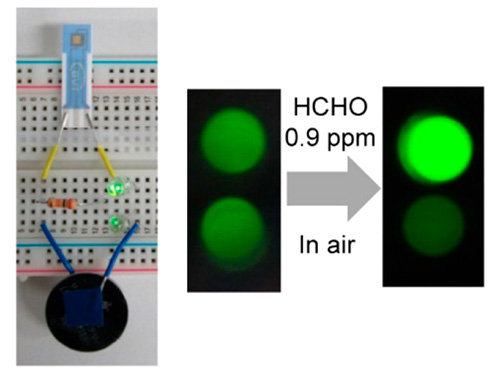- ホーム
- > 研究活動
- > Research Highlights
- > Vol. 35 Environmental Monitoring of・・・
 Research Highlights
Research Highlights
[Vol. 35]
Environmental Monitoring of Air Pollution: ‘Detect to Warn’ Sensing System for Monitoring Formaldehyde
Compact ‘referenced—chemiresistive-sensors’ consisting of network-assembly of semiconducting carbon nanotubes and hydroxylamine hydrochloride enable highly selective and continuous measurement of formaldehyde for environmental monitoring.

Figure: Reference and sensing devices are visualized using LEDs. The presence of formaldehyde is shown by the brighter LED.
Formaldehyde (HCHO) and related chemical compounds used in the construction industry to prevent decay of building materials are known to cause dermatitis, asthma, and other such ailments. Such health issues related indoor air pollution–referred to as ‘sick building syndrome’–is a global problem with World Health Organization (WHO) guidelines recommending a maximum permissible concentration of HCHO of 0.08 ppm indoors. But monitoring levels of HCHO is not trivial, with conventional technology being expensive, bulky, and although compact monitoring systems exist, they require renewal of ‘detection tags’ after each measurement, and have issues related to continuous and long term monitoring.
Here, Shinsuke Ishihara and colleagues at the WPI-MANA, National Institute for Materials Science in Tsukuba and collaborators at the Nanomaterials Research Institute, National Institute of Advanced Industrial Science and Technology (AIST), Tsukuba, report on the development of an innovative HCHO detection system based on a combination of hydroxylamine hydrochloride and network-assembly of semiconducting single walled carbon nanotube (SWCNTs) sensors capable of highly selective and continuous monitoring. Specifically, the SWCNT sensor is reusable; has a detection limit of 0.016 ppm; HCHO-selectivity of 105 to 106 times higher than other vapors such as water and methanol; and the implementation of a reference sensor adjacent to an active one prevents false positives.
The reaction of HCHO with hydroxylamine hydrochloride generates hydrochloric acid, which causes changes in the conductivity of the SWCNTs that are measured with an external electrical circuit. The reference sensor does not have hydroxylamine hydrochloride present at its surface, hence the sensor does not react to HCHO.
“The high performance and versatility of our sensors was achieved by designing devices with precise separation of semiconducting carbon nanotubes, monodisperse treatment of carbon nanotubes and improvement of active surface area by networking,” says Ishihara. “Furthermore, our sensor is low cost, portable, and long lifetime, thereby making it suitable as a ‘detect to warn’ sensory system.”
Reference
“Amperometric Detection of Sub-ppm Formaldehyde Using SingleWalled Carbon Nanotubes and Hydroxylamines”
Shinsuke Ishihara[1], Jan Labuta[1], Takashi Nakanishi[1], Takeshi Tanaka[2], and Hiromichi Kataura[2]
Journal : A Referenced Chemiresistive System. ACS Sens. 2, 1405–1409, (2017).
DOI : 10.1021/acssensors.7b00591
(This paper is also highlighted by ACS Select Virtual Issue: Advances in Electroanalytical Chemistry; see J. Am. Chem. Soc. 140, 2701–2703, (2018))
Shinsuke Ishihara[1], Jan Labuta[1], Takashi Nakanishi[1], Takeshi Tanaka[2], and Hiromichi Kataura[2]
Journal : A Referenced Chemiresistive System. ACS Sens. 2, 1405–1409, (2017).
DOI : 10.1021/acssensors.7b00591
(This paper is also highlighted by ACS Select Virtual Issue: Advances in Electroanalytical Chemistry; see J. Am. Chem. Soc. 140, 2701–2703, (2018))
Affiliations
[1] World Premier International Center for Materials Nanoarchitectonics (WPI-MANA), National Institute for Materials Science, (NIMS), Tsukuba, Ibaraki 305-0044, Japan
[2] Nanomaterials Research Institute, National Institute of Advanced Industrial Science and Technology (AIST), Tsukuba, Ibaraki, 305-8565, Japan
[2] Nanomaterials Research Institute, National Institute of Advanced Industrial Science and Technology (AIST), Tsukuba, Ibaraki, 305-8565, Japan
Contact information
ナノアーキテクトニクス材料研究センター (MANA)
〒305-0044 茨城県つくば市並木1-1
TEL: 029-860-4710
E-mail: mana-pr=ml.nims.go.jp([ = ] → [ @ ] )
TEL: 029-860-4710
E-mail: mana-pr=ml.nims.go.jp([ = ] → [ @ ] )

